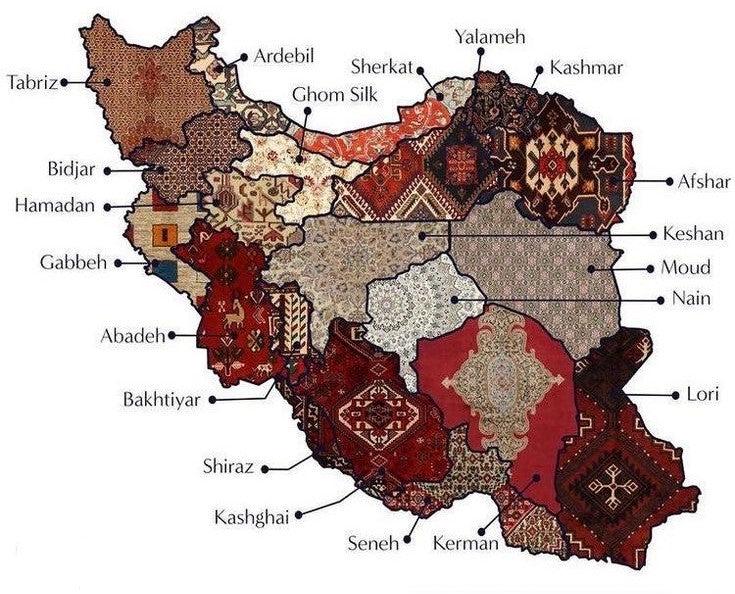Persian Rug Styles by Region Map


David Chen
Data Visualization Specialist
David Chen is an expert in transforming complex geographic datasets into compelling visual narratives. He combines his background in computer science ...
Geographic Analysis
What This Map Shows
The "Persian Rug Styles by Region Map" visualizes the intricate tapestry of Persian rug craftsmanship across different regions of Iran. Each area showcases its unique style, color palette, and weaving techniques, reflecting the diverse cultural heritage and traditions of its people. This map serves as a guide to understanding how geography and culture intertwine in the creation of these beautiful textiles, which have become synonymous with Persian art.
Deep Dive into Persian Rugs
Persian rugs are not just decorative items; they are a rich representation of Iran's history, culture, and geographical diversity. The art of rug-making in Persia has its roots in ancient traditions, with many designs dating back centuries. Interestingly, the patterns and motifs found in Persian rugs are often influenced by the region’s history, climate, and the materials available for weaving.
Rugs are typically made from wool, silk, or a blend of both, with the choice of material greatly affecting the rug's texture and durability. Wool rugs, for example, are known for their warmth and resilience, making them ideal for everyday use, while silk rugs are prized for their luxurious feel and intricate designs.
Moreover, the techniques used in weaving also vary by region. The most common weaving technique is the Persian knot, which creates a dense, intricate design that is characteristic of high-quality rugs. However, some regions may use different methods, leading to variations in the thickness and appearance of the rugs.
In terms of design, Persian rugs often feature floral and geometric patterns, but these motifs can differ significantly between regions. For instance, Kashan rugs are known for their elaborate floral designs, while Tabriz rugs often incorporate intricate medallion patterns. What's fascinating is that each design tells a story, often representing local legends or historical events.
Regional Analysis
The map categorizes Persian rugs into several key regions, each with its distinctive styles:
1. **Kerman**: Known for its fine quality and intricate designs, Kerman rugs often feature elaborate floral patterns. The use of vibrant colors is a hallmark of this region, making these rugs highly sought after.
2. **Tabriz**: Rugs from Tabriz are celebrated for their detailed medallions and a wide range of colors. This region has a long history of rug production, and Tabriz rugs often blend traditional motifs with contemporary design elements.
3. **Isfahan**: The city of Isfahan is famous for its silk rugs with elaborate, symmetrical designs. These rugs often showcase a central medallion with intricate borders, reflecting the city’s rich artistic heritage.
4. **Nain**: Nain rugs are known for their delicate patterns and soft color palettes, often incorporating a signature blue dye. The intricate designs often include floral motifs and medallions, making them a favorite among collectors.
5. **Mashhad**: Rugs from Mashhad are typically larger and feature bold, vibrant designs. They often include religious themes and motifs, reflecting the region’s significance in Iranian culture.
Each of these regions contributes to the rich tapestry of Persian rug styles, demonstrating how geography and culture shape artistic expression. The differences in design, material, and techniques provide a fascinating insight into the lifestyles and traditions of the people who create these masterpieces.
Significance and Impact
Understanding the diversity of Persian rug styles is essential not only for art enthusiasts but also for those interested in cultural heritage. Persian rugs have transcended their functional purpose, becoming symbols of art and craftsmanship. They are often seen as investments, with certain rugs fetching high prices at auctions due to their historical significance and quality.
Moreover, the rug industry plays a crucial role in the Iranian economy, providing livelihoods for countless artisans and weavers. Interestingly, as global demand for authentic Persian rugs continues to grow, so does the challenge of preserving traditional techniques in the face of modernization and mass production.
In recent years, there has been a resurgence of interest in handcrafted goods, with consumers increasingly seeking unique, culturally rich products. This shift offers a promising outlook for the future of Persian rug production, as it encourages artisans to continue their craft while also adapting to contemporary tastes.
In conclusion, the Persian rug styles by region map offers a window into the vibrant world of Persian textiles. By exploring the rich diversity of designs and techniques, we can appreciate not only the beauty of these rugs but also the cultural stories they represent, ensuring that this ancient art form continues to thrive in modern times.
Visualization Details
- Published
- October 24, 2025
- Views
- 10
Comments
Loading comments...